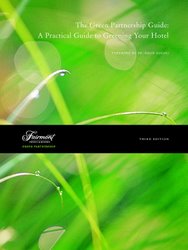Fairmont Hotel’s Green Guide
 Fairmont Hotels & Resorts has just launched the third edition of its acclaimed Green Partnership Guide, a comprehensive instructional text for companies looking to “green” their operations. The guide gives information on Fairmont’s best environmental practices, such as energy management, water conservation, and innovative community outreach programs. In addition, it provides details on how to start, maintain and grow an environmental program, including case studies on reducing operating costs, keeping employees motivated and tracking cost savings.
Fairmont Hotels & Resorts has just launched the third edition of its acclaimed Green Partnership Guide, a comprehensive instructional text for companies looking to “green” their operations. The guide gives information on Fairmont’s best environmental practices, such as energy management, water conservation, and innovative community outreach programs. In addition, it provides details on how to start, maintain and grow an environmental program, including case studies on reducing operating costs, keeping employees motivated and tracking cost savings.
If it tells you to buy carbon credits, I might throw up. In the meantime, here are some samples from the book:
- At The Fairmont Royal York in Toronto, the hotel installed a commercial water softener that reduced laundered water use to 1 wash and 1 rinse per cycle, saving 125,000 gallons of water per day, roughly enough water to supply 500 homes. Adding to this reduction, the hotel also took advantage of the city’s new ICI Water Saver Program, which rewards industrial, commercial and institutional water savings, and received close to $50,000 for their efforts.
- In 2006, The Fairmont Sonoma Mission Inn & Spa completed an extensive lighting retrofit, replacing 4,440 incandescent bulbs with energy-efficient fluorescent lighting. As a result, the hotel now saves over 203,000 kilowatt-hours of energy annually representing a cost savings of $61,000. Located in eco-conscious California, the resort was also able to recoup the majority of its capital investment with an energy rebate from the state’s Public Utilities Commission.
- At Bermuda based Fairmont Southampton the hotel conserves water through a sophisticated golf course irrigation system. Following treatment, gray water from throughout the resort is recycled to irrigate the golf course and grounds. Central controls allow for accurate application and scheduling, based on turf needs and weather conditions.
- At The Fairmont Dallas, the hotel instituted several initiatives to improve its energy and water conservation performance. In its tower guestrooms the hotel fitted windows with reflective tinting, a practice which is expected to reduce energy consumption by 416666 kWh and save the property $50,000 on its electricity costs. Additionally, all guestrooms now have digital thermostats, allowing for pinpoint temperature accuracy, a move that will reduce energy usage by an additional 208333 kWh.
- In Alberta, The Fairmont Chateau Lake Louise has been purchasing green power since 1999 and presently 40% of the property’s electricity needs are met by a blend of wind and run-of-river electricity generation. Green power, derived from sources including wind, run-of-river hydro, and biomass, has minimal environmental impacts and produces little or no greenhouse gas emissions.
- Also supporting alternative energy technology is The Fairmont Washington, D.C., which also directs some of its electricity dollars to wind power. Other innovative green initiatives at the hotel include the elimination of toxic cleaning chemicals and encouraging staff to use public transportation by way of MetroCheck, a program enabling hotel colleagues to purchase monthly MetroRail, MarcTrain and VRE passes with pre-tax dollars.
- The innovative engineering team at The Fairmont Waterfront installed a heat-recovery system at that captures condensate, steam that has been condensed back into water, from domestic hot-water tanks, and then uses it to preheat incoming city water. This process saves an estimated 305,380 kilowatt-hours (1,100 GJ) per year, roughly the same amount of energy it would take to power approximately 7 average-sized homes.
If you’re interested in purchasing The Green Partnership Guide, contact Fairmont’s office of environmental affairs at environment@fairmont.com.